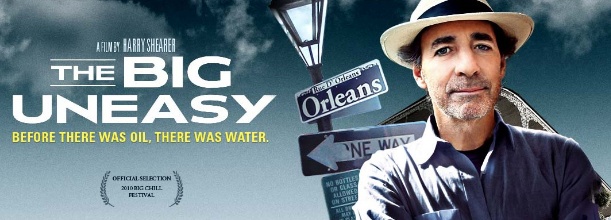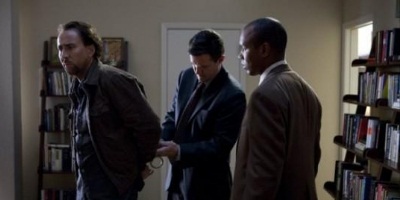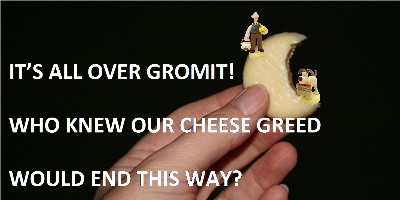Harry Shearer talks The Big Uneasy

Harry Shearer has the kind of CV we’d fall down and worship, if we weren’t afraid of ruining the pictures of him we’ve got strapped to our knees. Not only is the American comic the voice of all our Simpson’s favourites (Mr Burns, Smithers, Ned Flanders, Rev Lovejoy, the list goes on), but he also co-wrote and starred in one of the greatest cult films of all time; Spinal Tap. This is Derek Smalls we’re talking about here. However, over the past five years he’s been engaged with a very different project – filming his new documentary The Big Uneasy; an expose of the atrocious blunders made by the US government at the time of Hurricane Katrina, and the real reason New Orleans lost 80% of its surface area to flooding.
In this fascinating documentary, Shearer gradually uncovers the truth about the flood prevention measures taken before and after Hurricane Katrina. When the floodwalls collapsed on August 29th, it was assumed that the floods had overtopped the levee walls, making prevention impossible. This, Shearer and his expert team assures us, was not the case. The water never hit the tops of the walls. The hundreds of deaths in New Orleans were caused by defects in the levees themselves, defects that, most harrowingly of all, still stand in the floodwalls that protect New Orleans today.
After seeing – and being utterly astonished by – the film, we sat down with the man himself to find out more. After first complimenting him on his choice of shirt (manners don’t cost a penny), we couldn’t help but instantly wonder what made a man so entrenched in comedy history decide his next project would be a harrowing and intensely political documentary?
“Well, having spend so much time in New Orleans over the years,” (he describes himself as “a part time resident”) “it was important to me that people understand what really happened out there.” he says, “After Katrina hit I spent a lot of time interviewing people like Rob (Robert Bea, Engineering Professor at Berkeley University), and Ivor (Van Heerden, a Marine Science Expert) on my radio show. They were the people heading up the independent investigation on why the levees had failed. It became obvious that what they were discovering didn’t match what the media was saying”
What they were discovering was that US Army Engineering Corps of America – those responsible for the design and construction of the levees – had constructed floodwalls that were innately flawed, based on designs that were grossly outdated. And not only that, but the levees that were – are – still standing, still have the same basic flaws. According to Ivor Van Heerden and The Louisiana State Univeristy Hurricane centre, these floodwalls should never have passed safety regulations. But, Heerden’s team were to publish their findings and their vital discoveries was largely – if not entirely – ignored by those in power.
“The information was all there.” he says, “It was actually pretty easy for me to find it, it just meant quite a few evenings in dusty university libraries. It wasn’t even suppressed, it was just ignored by everyone.”
And what about the media? Surely they were interested in publicising this potential life-saving information, especially when it was available so freely?
“The media had their story, they were done. They’d collectively decided that it was a “natural disaster”, that it was a “Hurricane Katrina” disaster, and once they’d stated that on the front page that was it.”
And it wasn’t just Ivor’s team that was getting ignored. One of the most harrowing sequences in The Big Uneasy comes in the testimony of Maria Garzino, contract specialist for the Army Corps of Engineers, who was employed to test and install large water pumps in New Orleans post-Katrina. She became increasingly worried about the defects she found in the pumps, and released an internal memo warning that the machinery would not pass testing. Over and over again, she was ignored – first by superiors and then by federal oversight agencies, until it was too late. How can such important research get tossed by the wayside?
“It comes down to a culture of impunity,” says Shearer, “There were, and are, no consequences for the actions of the Army Corps of Engineers. They mess up, the government comes to them and says “You messed up, here’s 30 million dollars to fix it”. Until that changes, nothing will.”
It’s almost impossible not to get swept away with Shearer’s passion for the injustices he has discovered. The problem is that the picture he paints is so bleak, it’s almost impossible to see what he hopes will happen as a result of his work. When asked if he believes anything can be done to implement change in this government system, his reply is swift and brief. “It was to come from Obama. It has to come from the top.That’s the only way.”
So, having put so much into this project, does he think the experience has changed the way he thinks about his own future as a film-maker?
“ I was actually thinking about that this morning,” he muses, “I was thinking about how much work I’d put into this and thinking to myself, wow, I definitely never want to do that again.” He laughs, “but you know, it was amazing working on a project that I had such a white-hot passion for, especially coming from a background of comedy where, actually, you kind of have to be irresponsible, you kind of have to not care in order for it to work. All of a sudden, I was responsible, and that was felt very, very different.”
So does this mean his next project will swing more towards comedy than politics?
He chuckles. “yeah maybe. It would be nice to be silly for a little while again.”
And with that, we let Harry Shearer go, restraining ourselves from elbowing in a “smell the glove” reference upon his retreat. Well done us. And we have to say, having been rather dazzled by pretty much every facet of the showbusiness gem that is Harry Shearer, we can’t help but think that whatever he tries his hand at next, we can guarantee he’ll turn it up to eleven. Damn. So close.
You can read our review of The Big Uneasy here, go forth!







Recent Comments